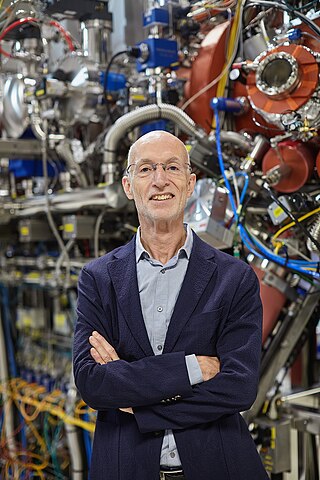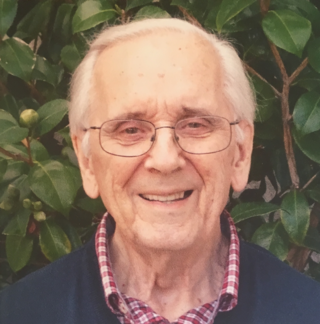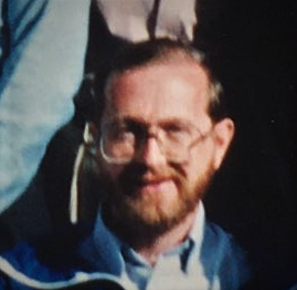
A hard disk drive (HDD), hard disk, hard drive, or fixed disk, is an electro-mechanical data storage device that stores and retrieves digital data using magnetic storage with one or more rigid rapidly rotating platters coated with magnetic material. The platters are paired with magnetic heads, usually arranged on a moving actuator arm, which read and write data to the platter surfaces. Data is accessed in a random-access manner, meaning that individual blocks of data can be stored and retrieved in any order. HDDs are a type of non-volatile storage, retaining stored data when powered off. Modern HDDs are typically in the form of a small rectangular box.

A disk read-and-write head is the small part of a disk drive which moves above the disk platter and transforms the platter's magnetic field into electric current or, vice versa, transforms electric current into magnetic field. The heads have gone through a number of changes over the years.

Drum memory was a magnetic data storage device invented by Gustav Tauschek in 1932 in Austria. Drums were widely used in the 1950s and into the 1960s as computer memory.
Non-volatile memory (NVM) or non-volatile storage is a type of computer memory that can retain stored information even after power is removed. In contrast, volatile memory needs constant power in order to retain data.

Magnetic storage or magnetic recording is the storage of data on a magnetized medium. Magnetic storage uses different patterns of magnetisation in a magnetizable material to store data and is a form of non-volatile memory. The information is accessed using one or more read/write heads.

Stuart Stephen Papworth Parkin is an experimental physicist, director at the Max Planck Institute of Microstructure Physics in Halle and an Alexander von Humboldt Professor at the Institute of Physics of the Martin-Luther-University Halle-Wittenberg.

In 1953, IBM recognized the immediate application for what it termed a "Random Access File" having high capacity and rapid random access at a relatively low cost. After considering technologies such as wire matrices, rod arrays, drums, drum arrays, etc., the engineers at IBM's San Jose California laboratory invented the hard disk drive. The disk drive created a new level in the computer data hierarchy, then termed Random Access Storage but today known as secondary storage, less expensive and slower than main memory but faster and more expensive than tape drives.
William A. Goddard was an American engineer and inventor. He earned a degree in physics from Occidental College. Before working in industry, Goddard was a high school science teacher in Los Angeles. He briefly worked in the aerospace industry for North American Aviation, Inc. before becoming an engineer at International Business Machines (IBM). His most acclaimed achievement is co-inventing along with John Lynott United States Patent 3,503,060, which is entitled “Direct Access Magnetic Disc Storage Device”. This invention claims cover modern-day hard disk drives.
John Mason "Jack" Harker was an inventor, mechanical engineer, and product and program manager who pioneered development of disk storage systems. Starting as a member of the original team that developed the first disk storage system, he went on to develop IBM Direct Access Storage products for the next 35 years. Over that time, Harker was twice director of the IBM San Jose Storage Laboratories, an IBM Fellow, and an IEEE Fellow. He retired from IBM in 1987 and died in 2013.
John Wilson Haanstra was an American electrical engineer and a computer industry executive. Haanstra was notable for his chairmanship of IBM's SPREAD task force whose work led to the creation of the System/360 product line.

Yoshihiro Shiroishi was born in 1951 in Tokyo, Japan. He is a Chief Architect and Technical Advisor at the Hitachi Research & Dev. Group, Tokyo, Japan. Shiroishi was named Fellow of the Institute of Electrical and Electronics Engineers (IEEE) in 2015 for leadership in the development of high density magnetic recording technologies and devices.

Bruce Alvin Gurney was an American physicist responsible for pioneering advances in magnetic recording. In particular, he was central to the development of the giant magnetoresistance (GMR) sensors first used in hard disk drives in 1997.

Charles Denis Mee was a British-American engineer, physicist, and author who was noted for his contributions in the areas of magnetic recording and data storage on hard disk drives (HDD). A large part of his career was with IBM in San Jose California. He is the author or editor of several books on magnetic recording.

James "Jim" U. Lemke was an American physicist and entrepreneur who lived in San Diego. He developed magnetic recording and internal combustion engine technologies.

Mason Lamar Williams III was an engineer and physicist, noted for his contributions in the areas of magnetic recording and data storage on hard disk drives (HDD). A large part of his career was with the IBM Almaden Research Center in San Jose, California. After retiring, Williams played a major role in the restoration and demonstration of the IBM RAMAC at the Computer History Museum in Mountain View, California

Robert E Fontana is an engineer, physicist, and author who is noted for his contributions in the areas of magnetic recording and data storage on hard disk drives (HDD) and on digital tape recorders. His work has concentrated on developing thin film processing techniques for nano-fabrication of magnetic devices including Giant Magnetoresistance read heads now used universally in magnetic recording. Much of his career was with IBM in San Jose, California. He is a Fellow of the Institute of Electrical and Electronics Engineers and a member of the National Academy of Engineering.

Michael L. Mallary is an engineer, physicist, inventor, and author who is noted for his contributions in the areas of magnetic recording and data storage on hard disk drives (HDD). His work has concentrated on developing and optimizing magnetic components to maximize data storage density. In particular, he is responsible to inventing the 'trailing-shield' write head used universally in modern HDDs. Mallary is a Fellow of the Institute of Electrical and Electronics Engineers and recipient of the IEEE Magnetics Society Achievement Award.

David A. Thompson is an American electrical engineer and inventor with a long career at IBM. He is noted for his many contributions to magnetic recording technology. Thompson was inducted into the National Inventors Hall of Fame for the invention and development of the thin-film inductive head and the magnetoresistive read head. These heads are now ubiquitous in all hard-disk drives and magnetic tape recorders.
Albert Smiley Hoagland had a long career on the development of hard disk drives (HDD) starting with the IBM RAMAC. From 1956 to 1984, he was with IBM in San Jose, California, and then, from 1984 to 2005, he was the director of the Institute for Information Storage Technology at Santa Clara University. He wrote the first book on Digital Magnetic Recording. Hoagland played a central role in the preservation and restoration of the IBM RAMAC now displayed at the Computer History Museum, Mountain View, California. He died in Portland, Oregon, on 1 October 2022.

Tu Chen 陳都 is a Taiwanese-American scientist and entrepreneur who played a central role in the development of thin-film media for computer hard disk drives. In 1993, he co-founded Komag which was subsequently purchased by Western Digital in 2007. Since his retirement in 1999, Chen has devoted himself to technological advancement in Taiwan.















